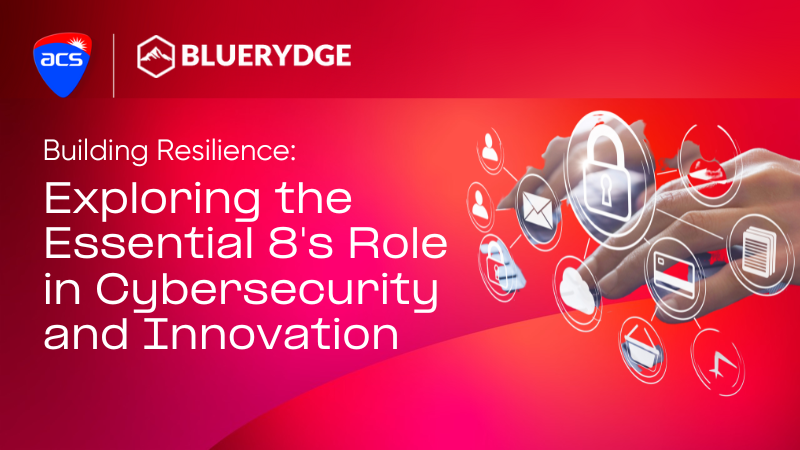
Building Resilience: Exploring the Essential Eight's Role in Cybersecurity and Innovation
Highlights
- In an era dominated by digital transformation and ever-evolving cyber threats, organisations must strike a delicate balance between innovation and security. One framework that has gained prominence in this context is the "Essential Eight."
- Developed by the Australian Cyber Security Centre (ACSC), this set of security strategies provides a comprehensive approach to enhancing an organisation's resilience against cyber threats while allowing room for innovation and growth.

The Essential Eight Explained
The Essential Eight is a strategic framework consisting of eight essential security strategies designed to mitigate the most common and damaging cyber threats. These strategies are not intended to be a one-size-fits-all solution but rather a flexible set of guidelines that organisations can tailor to their specific needs and risk profiles.
- Application Control: This strategy involves creating a list of approved and trusted applications that are allowed to run within an organisation's environment. By restricting the execution of unauthorised applications, organisations can significantly reduce the risk of malware and other malicious software infiltrating their systems.
- Patch Applications: Regularly updating and patching applications is essential to eliminate known vulnerabilities. Cyber criminals often exploit these vulnerabilities to gain unauthorised access or launch attacks.
- Configure Microsoft Office Macro Settings: Cyber criminals frequently use malicious macros in Microsoft Office documents to deliver malware. Blocking macros from the internet and only trusting digitally signed macros can mitigate this risk.
- User Application Hardening: By configuring web browsers and email clients to block or warn against common web-based attacks, organisations can enhance their defence against threats such as phishing and drive-by downloads.
- Restrict Administrative Privileges: Limiting access to administrative accounts can significantly reduce the risk of unauthorised changes to systems and data. Only authorised personnel should have elevated privileges, and these should be used sparingly.
- Patch Operating Systems: Just as with applications, keeping operating systems up to date is crucial. Regularly applying security patches ensures that known vulnerabilities are addressed promptly.
- Multi-Factor Authentication (MFA): MFA adds an additional layer of security by requiring users to provide two or more forms of identification before gaining access to systems or data. This strategy is particularly effective in preventing unauthorised access, even if passwords are compromised.
- Regular Backups: Regular backups are essential for data recovery in the event of a cyber attack or system failure. Daily backups help ensure that organisations can quickly restore their systems and data to a known, secure state.
Balancing Security and Innovation
The Essential Eight is not about stifling innovation but rather about enabling it securely. Organisations can use these strategies as a foundation to build a robust cybersecurity posture that supports their innovation initiatives. Here's how:
- Proactive Risk Mitigation: By implementing the Essential Eight strategies, organisations can proactively mitigate common cyber risks. This, in turn, allows them to focus on innovation without the constant fear of falling victim to preventable threats.
- Increased Trust: Customers and partners are more likely to trust organisations that take their cybersecurity seriously. Demonstrating compliance with the Essential Eight can enhance an organisation's reputation and open doors to new opportunities.
- Scalable Security: The Essential Eight is scalable, meaning organisations of all sizes and industries can adapt and implement these strategies. Whether you're a startup, multinational corporation or government department, the framework provides a flexible approach to security.
- Compliance and Regulation: Many industries are subject to specific cybersecurity regulations and compliance requirements. The Essential Eight can serve as a solid foundation for meeting these obligations while innovating securely.
- Incident Response Readiness: Innovation often involves taking risks. Having a strong cybersecurity posture based on the Essential Eight ensures that organisations are better prepared to respond to any incidents or breaches that may occur during the innovation process.
In conclusion, the Essential Eight is a valuable framework for organisations seeking to innovate securely in today's digital landscape. It provides a roadmap for enhancing cybersecurity without stifling innovation, offering a balanced approach that supports growth and resilience. As organisations continue to evolve in an increasingly digital world, embracing the Essential Eight can be a strategic decision that pays dividends in the form of enhanced security and sustained innovation.
Bluerydge's tailored solutions can seamlessly integrate the Essential Eight framework into your organisation's cybersecurity strategy. With our expertise, we empower you to innovate securely, safeguarding your assets while driving growth and resilience.
Contact Bluerydge today to find out how the team can collaborate on secure and innovative solutions for you or
Register for Bluerydge sponsored event on the 5th Oct 2023, 5:30 PM AEDT, and bring your questions for discussion.
- ACS Panel Session: Essential 8 maturity in innovation (In-person), register here and (Virtual), register here
About the ACS Canberra Hub
The Hub is a custom-built collaborative space for members to drop by and use as a hotspot for meetings and events. Meeting room hire is also available to members and non-members.
Click here to find out more about the room hire rate or click here to book a room for your next meeting/event.
